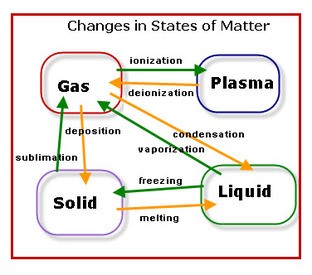Properties and States of Matter Worksheet
Grade 8 Science Worksheets
The universe is made of matter. The tiniest of particles, Atoms, combine to form molecules, which are the building blocks for all forms of matter. There are primarily three physical states of matter – solid, liquid, and gas. A fourth state, plasma, is very common in the universe but not so common on earth.
Click here to Jump Straight to Properties and States of Matter Worksheets.
Reinforce Learning with States of Matter Worksheets
Solids have a form and do not undergo change in shape easily, such as wood or stone.
Liquids have no shape of their own and take the shape of whatever they are kept in, such as water or gasoline.
Gases have no definite shape or volume, they expand in all direction or they can be compressed in a small space, such as hydrogen or helium gas.
Plasma is formed by providing intense heat to gas, causing it to “ionize” – i.e. the electrons have escaped their atoms. It is commonly found inside stars in the universe. On earth it needs to be specially created. Some examples are neon signs, fluorescent lamps and plasma TVs.

Schedule a Free session to clear worksheet doubts
No credit card required, no obligation to purchase.
Just schedule a FREE Sessions to meet a tutor and get help on any topic you want!
Physical Properties of Matter
These states of matter have physical properties that distinguish them from one another. Some of the physical properties are tabulated below:

Energy and Matter
All matter has energy. One form of energy is in the movement of particles that make up matter. It is this movement of particles that help define the properties of matter itself. The energy of moving matter is called Kinetic Energy.
Solid particles have the least energy to move, which is why they don’t change shape easily. Liquid particles have more energy than solid particles and gas particles have most of all. Hence, Kinetic Energy increases as the fluidity of matter increases (from solid to liquid to gas to plasma).
Another form of energy, Potential Energy, is associated with the position or condition of matter. It is associated with the matter at rest, yet having the ‘potential’ to do work in that state. Examples include the potential for a solid to fall from a height or for water behind a dam to flow to a lower position. Solids have higher potential energy due to the closeness of their particles. A solid with the ‘potential’ to fall down has more potential energy than a liquid in that position and least of all for a gas in that position. Hence, Potential Energy decreases as the fluidity of matter increases (from solid to liquid to gas to plasma).

Check Point
- Two or more atoms combine to form a ______.
- Intensely heating a gas creates a state called ______.
- Which particles have the most Kinetic Energy?
- Liquids
- Solids
- Plasmas
- Gases
- Which particles have the most Potential Energy?
- Liquids
- Solids
- Plasmas
- Gases
- The form of energy associated with moving matter is called ______ energy.
Answer Key
- Molecule
- Plasma
- c) Plasmas
- b) Solids
- Kinetic
Learn more about States and Properties of Matter and other important topics with 8th Grade Science Tutoring at eTutorWorld. Our expert science tutors break down the topics through interactive one-to-one sessions. We also offer the advantage of customized lesson plans, flexible schedules and convenience of learning from home.
What are the three common states of matter?
The three common states of matter are solid, liquid, and gas. Each state has its own unique characteristics and properties.
What is the difference between a physical property and a chemical property of matter?
Physical properties describe the characteristics of matter that can be observed or measured without changing the substance’s identity. Chemical properties, on the other hand, describe how matter behaves in the presence of other substances and involve its ability to undergo chemical reactions.
Are there 8 states of matter?
While the traditional states of matter include solid, liquid, and gas, the concept of eight states of matter is a topic of ongoing scientific exploration and debate. While additional states such as plasma, Bose-Einstein condensate, and some exotic states like quark-gluon plasma have been observed or theorized, the categorization of matter into distinct states is not universally agreed upon. The study of matter’s different forms and behaviors is a dynamic field, and scientists continue to investigate and discover new states of matter, expanding our understanding of the fundamental nature of the physical world.
Can matter change from one state to another?
Yes, matter can undergo phase changes such as melting, freezing, evaporation, condensation, and sublimation, which involve the transformation between different states of matter.
What are some examples of physical properties of matter?
Examples of physical properties include color, density, melting point, boiling point, conductivity, solubility, and flexibility.
eTutorWorld Understands Math Tutoring | Online Math Worksheets are Important Tools
Understanding graphs, charts, and opinion polls in a newspaper, for calculating house and car payments, and for choosing a long-distance telephone service are impossible without strong math skills …and the only way to develop strong math skills is by constant practice.
‘Practice makes a man perfect’ holds true for no other field better than for math. A middle or high school student must set aside a minimum of an hour for math every day. Other than textbooks, worksheets help you revise and understand concepts better.
Our expert tutors prepare online maths worksheets that are age and grade-appropriate. Grade-wise math worksheets for Elementary Math, Arithmetic, Pre-Algebra, Algebra, Geometry, Trigonometry, Statistics, Pre-Calculus and Calculus can be solved to improve math skills, to get ahead or to even catch up.
You may download these FREE online math worksheets in the PDF format, and then print and email us their solutions for a free evaluation and analysis by eTutorworld’smath expert tutors.
You may solve these worksheets by yourself or with your peers while studying together.
The Answer Key at the end of each worksheet allows for a self-evaluation.
Personalized Online Tutoring
eTutorWorld offers affordable one-on-one live tutoring over the web for Grades K-12, Test Prep help for Standardized tests like SCAT, CogAT, MAP, SSAT, SAT, ACT, ISEE and AP. You may schedule online tutoring lessons at your personal scheduled times, all with a Money-Back Guarantee. The first one-on-one online tutoring lesson is always FREE, no purchase obligation, no credit card required.
For answers/solutions to any question or to learn concepts, take a FREE CLASS.
No credit card required, no obligation to purchase.
Just book a free class to meet a tutor and get help on any topic you want!
Pricing for Online Tutoring
| Tutoring Package | Validity | Grade (1-12), College |
|---|---|---|
| 5 sessions | 1 Month | $139 |
| 1 session | 1 Month | $28 |
| 10 sessions | 3 months | $269 |
| 15 sessions | 3 months | $399 |
| 20 sessions | 4 months | $499 |
| 50 sessions | 6 months | $1189 |
| 100 sessions | 12 months | $2249 |
8th Grade Free Worksheets
- The Universe
- Heredity
- Evolutionary Theory
- Structure of the atom
- Ethical Practices
- Unveiling the mystery behind the physical universe
- Components of the universe
- Celestial phenomena
- The tilt of Earth’s axis
- The causes of high and low tides
- Earth Systems
- Rocks and Fossils
- Weather and Climate
- Basics of chemical reactions
- Types of Chemical reactions – Endothermic, exothermic, oxidation, reduction reactions
- Catalysts and enzymes
- Compounds and mixtures
- Acids, Bases and pH Indicators
Images Credit:
https://eastmontscience.weebly.com/uploads/1/3/3/8/13389395/6406978.jpeg?312
IN THE NEWS

Our mission is to provide high quality online tutoring services, using state of the art Internet technology, to school students worldwide.
Online test prep and practice
SCAT
SSAT
ISEE
PSAT
SAT
ACT
AP Exam
Science Tutoring
Physics Tutoring
Chemistry Tutoring
Biology Tutoring
Math Tutoring
Pre-Algebra Tutoring
Algebra Tutoring
Pre Calculus Tutoring
Calculus Tutoring
Geometry Tutoring
Trigonometry Tutoring
Statistics Tutoring
Quick links
Free Worksheets
Fact sheet
Sales Partner Opportunities
Parents
Passive Fundraising
Virtual Fundraising
Our Expert Tutors
Safe and Secure Tutoring
Interactive Online Tutoring
After School Tutoring
Elementary School Tutoring
Middle School Tutoring
High School Tutoring
Home Work Help
Math Tutors New York City
Press
©2022 eTutorWorld Terms of use Privacy Policy Site by Little Red Bird
©2022 eTutorWorld
Terms of use
Privacy Policy
Site by Little Red Bird






